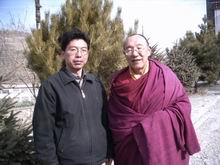Time: November 5,
2005, 14:30-17:30
Interviewing at: Ta'er Temple
Interviewee: Living Buddha Zhaxi
Longduodanqucuojia(Standing Committee of Chinese People’s Political
Consultative Conference, Chief of Ta’er Lamasery Red Cross and
Tibetan Medical School, Committeeman of Ta’er Lamasery Management
Committee)
Recorded by: Liu Fagang(Headmaster
of Dacai Middle School), Cao Yuanzhang(Teacher of Dacai Middle
School)
Q: Can you talk about Ta’er Lamasery?
A: Ta’er Lamasery was built on the birthplace of Tsongkhapa, the
founder of Gelug sect of Buddhism. It is one of the most famous
monasteries of Gelug sect, Since 1379 the Holy Pagoda was founded,
it has had the history of more than 600 years. Maitreya Buddha
Hall, built in 1560, has had the history of more than 400 years.
Ta’er Lamasery has 37 halls and most of them are Buddhist schools
and it covers the area of more than 400,000㎡.
Q: What is Tibetan Medicine?
A: Tibetan Medicine plays a key role in our traditional medicine
and has its own characteristics. The medicine is collected in
Tibet and has special curative effect and function. The treating
methods include medicine bath, taking medicine, applying ointment,
acupuncture, etc.
Q: Where are the monks from?
A: In the booming time, there were 3600 monks in Ta’er Lamasery.
According to a survey in 1954, Ta’er Lamasery had 1,724 monks,
and 980 of them were Tibetan, 358 Mongolian, 380 Tu nationality,
and 6 Han. Now we have more than 600 monks. The monks mainly come
from Huanzhong Qinghai province and Inner-Mongolia. Most of them
came here at the age of five or six years. 
Q: Why they chose to be monks?
A: The parents send their children to our lamasery. Some young
men are willing to become monk and some families have too many
children to support them so send boys here. We provide the above
monks board and lodge and their families afford other expenses.
To last their research and hand down property, the living Buddhas
make their relative’s kids become monks. The living Buddhas support
this kind of monks themselves.
The monks should undergo the procedures of haircut, bath and putting
on cassock. After formally acknowledging their teachers, the monks
will receive enlightening education of 3 to 5 years. Around ten
years old, the monks will study compulsory sutras in Xianzong
School. The over 20-year old monks after making commandments must
strictly abide by the religious disciplines, while some of the
monks never make commandments.
Q: What is the meaning of the titles Dalai and Panchen?
A: Dalai means ocean in Mongolian and Dalailama is the master
monk knowing everything about Buddhism. Panchen means master monk
with wisdom and bravery.
Q: Could you tell us something about peepul?
A: Peepul is regarded the symbol of Buddhism. Sakyamuni grasped
the truth of Buddhism under peepul. The place where Tsongkhapa
was born grew up a peepul with leaves having the pictures of Sakyamuni.
In all the monasteries are planted peepuls. Peepul is A fig tree
native to India, having broadly ovate leaves with a long terminal
projection.
|



